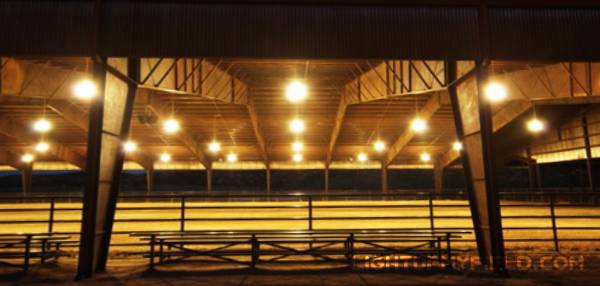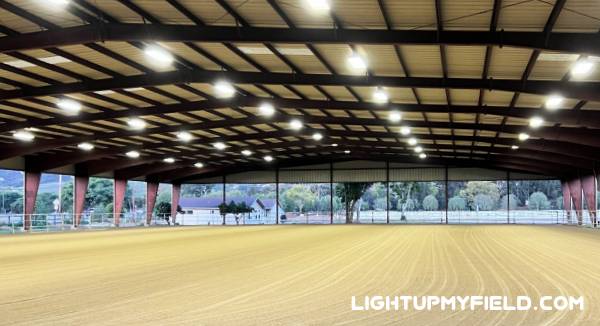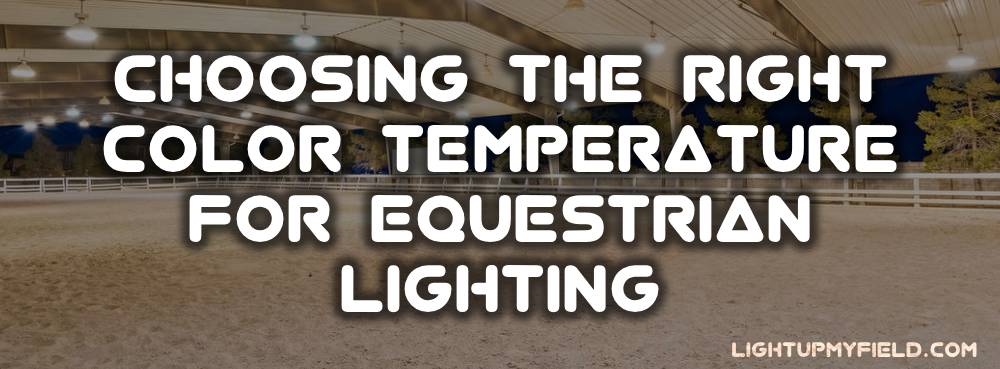When it comes to lighting up horse arenas, most folks tend to think about brightness and energy efficiency. But what often gets overlooked is the color temperature of the lights. It might sound like a fancy tech term, but color temperature actually makes a big difference—not just for how the arena looks, but also for the horses’ comfort and performance. Let’s explore why the color temperature matters, which ones suit different equestrian activities best, and what can happen if you pick the wrong tone.
Table of Contents
ToggleWhy Color Temperature Actually Makes a Difference for Horses
Color temperature is all about how “warm” or “cool” the light looks, and it’s measured in Kelvins (K). Imagine the difference between the soft, yellowish glow you get from a bedside lamp—that’s a warm light around 2700K—and the crisp, bluish tint you see on an overcast day, which can be 6000K or higher. When it comes to horses, this isn’t just about aesthetics. Their vision and mood can be quite sensitive to the type of light they’re exposed to.
Horses evolved to live under natural daylight, which usually sits somewhere between 5000K and 6500K. This range mimics the balanced, bright daylight they’re used to outside. When artificial lighting strays too far from that sweet spot, it can throw off their internal rhythms and even affect how they perceive their environment.
How Light Affects Horses’ Behavior and Health

Horses rely on natural light cues to regulate their sleep cycles, feeding, and general activity. If the lighting feels too warm—think around 2700K to 3500K like a cozy lamp—it might make them feel calmer or even a bit sleepy, which could be good for chill-out sessions but not so much for active training. On the other hand, cooler light above 5000K tends to stimulate alertness. This could be helpful when you want your horse sharp and focused, but if it’s too intense or harsh, some horses might get agitated or stressed.
Studies have shown that animals exposed to lighting conditions drastically different from their natural environment can experience increased cortisol levels—the stress hormone—which isn’t ideal for horses who need to stay calm and steady during riding or training. In fact, even small changes in lighting can affect their eye comfort; too much bluish light can cause eye strain, leading to squinting or avoiding certain spots in the arena. This kind of discomfort might seem minor, but over time, it could seriously impact their performance and well-being.
Why Horses Might React Differently Than Humans
You might think, “Hey, if the lights look good to me, they should be fine for my horse,” but it’s not quite that simple. Horses see colors differently than we do, with more sensitivity to certain wavelengths of light. Their eyes are adapted to pick up movement and contrast under natural daylight, so when artificial light doesn’t mimic that well enough, it can make their world look strange or even unsettling.
If the color temperature is off, horses could become nervous, distracted, or display unusual behaviors like refusing to enter certain areas or being jumpy. These reactions happen because their senses are telling them something feels “off,” even if we can’t always pinpoint what exactly. So, picking the right color temperature isn’t just about visual comfort for us—it’s about creating an environment that feels right to the horses spending hours in the arena.
Finding the Right Color Temperature for Different Types of Riding Arenas
 When it comes to lighting, one size definitely doesn’t fit all—especially in horse arenas. The color temperature you choose can totally change the feel of a space and how both horses and riders perform. It really depends on what kind of riding you’re doing and what atmosphere you want to create.
When it comes to lighting, one size definitely doesn’t fit all—especially in horse arenas. The color temperature you choose can totally change the feel of a space and how both horses and riders perform. It really depends on what kind of riding you’re doing and what atmosphere you want to create.
Equestrian Arenas for Training and Competition
If you’re working with dressage, jumping, or any kind of event where precision matters, cooler lights that mimic natural daylight are usually the way to go. Think 5000K to 6000K—that crisp, clean light helps riders see every little nuance of their horse’s movements and the footing beneath their hooves. It’s like giving your eyes a fresh pair of glasses to catch all the details.
This kind of lighting not only helps riders stay sharp but also keeps horses alert without overwhelming them. Studies have found that horses exposed to lighting close to daylight conditions tend to maintain better focus during training. So for competitions where every detail counts, leaning toward the higher end of the color temperature spectrum makes a lot of sense.
Rodeo and Performance Arenas
Rodeo events are fast-paced and full of energy, so the lighting needs to keep up without making things harsh or uncomfortable. A slightly warmer color temperature in the 4000K to 5000K range usually works well here. It’s bright enough to keep everything visible during quick movements, but with a bit of warmth to soften shadows and make the space feel more inviting.
This temperature range helps riders and horses stay comfortable during adrenaline-pumping moments. The warmer light also helps reduce glare that can sometimes distract during high-speed runs or tricky maneuvers, which is a big plus when split-second reactions matter.
Everyday Horse Training Arenas
For those who use arenas for regular training sessions—not super intense but not totally chill either—a middle ground is best. Lights around 3500K to 4500K hit that sweet spot. This range isn’t too cool or too warm, offering a balanced environment that encourages calm focus.
Horses tend to respond well to these moderate tones because they’re less likely to get jumpy or sluggish. Riders also appreciate not feeling like they’re in a hospital corridor (too bright and cold) or a dimly lit room (too soft and sleepy). It’s like striking a good balance between staying alert and feeling relaxed.
Recreational and Leisure Riding Areas
If your arena is more about kicking back, casual riding, or therapeutic work, then warmer lights around 3000K tend to be more popular. This softer, cozy lighting makes the space feel welcoming and less intense, which can help horses unwind and enjoy themselves.
A warmer light mimics those golden hours just after sunrise or before sunset when everything feels calm and peaceful. Horses under this kind of light are often less tense and more willing to engage in relaxed activities. It’s the difference between a bright office and a comfy living room vibe—both have their place, but when it’s about enjoyment and connection, softer light wins.
| Arena Type | Recommended Color Temperature (Kelvins) | General Vibe/Effect |
|---|---|---|
| Equestrian Training & Competition | 5000K – 6000K | Crisp, daylight-like; sharp detail & alertness |
| Rodeo & Performance Arenas | 4000K – 5000K | Bright but warm; reduces harsh shadows & glare |
| Everyday Horse Training | 3500K – 4500K | Balanced; calm focus without harshness |
| Recreational & Leisure Riding | Around 3000K | Warm, cozy; relaxing & less intense |
What Happens When Horses Are Exposed to the Wrong Color Temperature?
Picking the wrong color temperature for your arena lighting isn’t just about making the place look off—it can genuinely affect how horses feel and behave. Horses, like us, rely a lot on light to regulate their natural body clocks, or circadian rhythms. These rhythms control their sleep, energy levels, and overall mood. When the lighting is way too warm or way too cool compared to what they’re used to outside, it can throw their system out of whack, leaving them feeling restless or stressed.
The Impact of Harsh, Bright Lighting
If the arena lighting is too bright and on the cooler side—think above 6000K—it can cause some horses to squint or even act jumpy. The bluish tint of such lights might be too intense for their eyes, which are naturally built for softer daylight. Some horses might start avoiding certain areas of the arena simply because the glare makes them uncomfortable or disoriented. You might notice behaviors like sudden spooks or reluctance to move freely, which obviously isn’t great when you’re trying to get good training or a smooth ride.
When Warm, Dim Lights Cause Lethargy
On the flip side, if the lighting is too warm and dim—say around 2700K or lower—it can make horses feel sluggish or less responsive. It’s like being stuck in a room that’s too cozy for too long; you just want to relax instead of being alert. This kind of lighting might be okay for casual riding, but in a training or performance setting, it can dull a horse’s focus and make it harder for them to engage fully with the work at hand.
Long-Term Effects on Health and Performance
Beyond just behavior, long-term exposure to the wrong color temperature can have more serious consequences. Horses exposed to inconsistent or unsuitable lighting might experience elevated levels of cortisol, the stress hormone, which affects their immune system and overall health. Their eyesight can also suffer over time, especially if they’re constantly trying to adjust to harsh lighting conditions. Think about how exhausting it is for humans to spend hours under flickering or overly bright lights—it’s the same for horses, just multiplied.
The Bottom Line on Choosing Equestrian Lighting
Lighting isn’t just a technical detail when it comes to horse arenas. It’s part of creating a space where horses feel at ease and riders can perform their best. Getting the color temperature right means considering what the horses need as much as what looks good to people. Whether it’s a competition arena needing crisp daylight tones or a leisure space where warmer light helps horses chill out, the key is balance.
Spending a bit of time thinking about the right color temperature can pay off in smoother rides, happier horses, and a better overall atmosphere. After all, when horses and riders feel comfortable under the lights, the whole experience just feels better.

